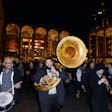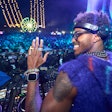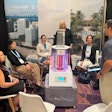At the BizBash Expo at Chicago's Merchandise Mart Thursday, educational sessions focused on topics such as financial strategies, social networking, and word-of-mouth marketing. In some of the panels, talk turned to the stabilizing effects of loyal planner-vendor relationships. And in all sessions, speakers stressed the importance of communication—whether between vendors and planners, or planners and the police force.
In a session dubbed "Planning Successful Events and Galas in Challenging Times," Lee Kite, director of distinguished events at the American Cancer Society, spoke about the relief she feels working with trusted vendors, explaining that unstable times are "a solid time for solid relationships." Along with golf outings, Kite plans the organization's annual Discovery Ball, and said that her "happy place—perhaps as much as calculating the take" is seeing vendors whom she has worked with in the past arrive at an event.
Though Kite said she accepts several RFPs annually as a standard business practice for planning the ball, she stressed the sanity-maintaining value in building relationships with vendors who know her standards and the quirks of a particular venue. Knowing that her event's execution is in trusted hands "lets me take a big, deep breath," she said.
Andrew Schorr, president and principal of In the Loop Chicago, also spoke on the panel. Although he understands planners' reasons for talking to more than one vendor in order to make the smartest hiring decision, he stressed the notion that cheapest isn't always best. "It's important to have honest conversations," he said. "If a vendor is offering you an unbelievable price, it's okay to ask 'why are you offering me this price?'"
Jodi Wolf, president of Paulette Wolf Events and Entertainment, spoke in a session called "Medical and Risk Emergency Planning for Events." Wolf shared her experience in overseeing logistics at large-scale events like the Ft. Lauderdale Air and Sea Show, where she has weathered emergencies such as a U.S. Navy Leap Frog landing on a catering truck. Though the latter incident resulted in a broken femur, "everything went smoothly in the end," Wolf said, "because we had a plan in place and a great system for communication." To help other planners avoid panic in unforeseen situations, Wolf dispensed the following advice: From the first run-through, event hosts should make sure that they have the cell phone numbers of everyone on the security team. She also advised having an ambulance on site for any event with more than 750 guests, and suggested using off-duty police officers for security whenever possible, as their calls to 911 tend to get faster responses than calls placed by planners or venue owners.
When it came time for the session's question-and-answer period, planners were interested in learning whom to call first in the event of an emergency. Though some venues recommend alerting an in-house contact as a first recourse, Wolf said it's best to first identify a problem, then call 911. A planner in the audience shared his tip: Before an event, vet the guest list for medical doctors.
Tom Kehoe, president of Kehoe Designs, shared some design-related observations in his appearance during the keynote session entitled "The Latest Trends in the Changing Event Landscape." According to Kehoe, the coming months will see event designers using vibrant colors to communicate subtle (and timely) messages of hope and joy. "If it's not neon, if it's not high-def, it's not hot," he said, in front of a screen that broadcast images from a recent event his team worked on, which incorporated lounge furniture swathed in fuchsia and orange fabrics and showcased a bar adorned with the words "Laugh," "Love," and "Live."
Another keynote speech from Andy Sernovitz, author of Word of Mouth Marketing: How Smart Companies Get People Talking, focused on viral communication. Sernovitz stressed the idea that "your brand is not what you say it is, it's what other people say it is." He reminded the audience that the majority of consumers turn to Google, rather than a company's official Web site, to learn more about a brand. Since the search engine will instantly pull up several customer reviews, Sernovitz said, smart companies focus on generating positive, user-generated buzz.
Techniques to generate positive reviews include offering exceptional customer service. As an example, Sernovitz shared an anecdote about Zappos.com. According to Sernovitz, when a consumer called a rep for the online shoe retailer to order a pizza—and ultimately received a pie on Zappos's dime—the quirky incident became fodder for discussion on several Web sites, and ultimately served as a free (or cost-of-a-pizza) advertisement for the site's devotion to its customers.
Along with giving consumers "a reason to talk" about a brand, Sernovitz advocated giving them the tools to make the word travel more easily. As an example, he cited Wi-Fi-equipped lounges at events, which allow bloggers to generate real-time content and start spreading immediate buzz. In keeping with the theme of the day, Sernovitz also advised brands to stay in constant communication with their consumers, and to continually ask what they can do to make it easier for bloggers and other product users to spread the word about a brand.
The next BizBash Expo is in New York on October 21. Information is at bizbashnewyorkexpo.com.



















